The Effects of Mycorrhizal Fungi Inoculum on Potato Yield
Introduction:
The Master Gardeners at Elkus Ranch designed a study to compare the yield and vigor of Carola potatoes grown with and without mycorrhizal fungi plant inoculum. Products claiming to increase size and health of plants have been made by a number of suppliers of inoculate, without providing supportive data. The goal of this trial was to document the planting, comparative growth and yields of potatoes, one inoculated and the other non inoculated, so that the results would help the home gardener make an educated choice on whether or not to use a mycorrhizal inoculum. The author chose to experiment with Carola potatoes because she has had excellent results with them over the years, and they are delicious. The study was conducted in a Zone 17 coastal climate.
Hypothesis:
Carola potatoes grown with endomycorrhizal fungi plant inoculum will be more vigorous and produce higher yields than Carola potatoes grown without inoculum.
Background: What is ‘endomycorrhizal fungi plant inoculum’?
A mycorrhiza, from the Greek ‘mykos’ meaning fungus and ‘riz’ meaning roots refers to a symbiotic association between a fungus and the roots of a vascular plant. They form an important component of soil life and soil chemistry.
In a mycorrhizal association, the fungus colonizes the host plant's roots, either intracellular as in endomycorrhizal fungi, or extracellular as in ectomycorrhizal fungi. This study is concerned with the former.
Mycorrhizal fungi form a mutual relationship with the roots of most plant species.
This association provides the fungus with relatively constant and direct access to carbohydrates, such as glucose and sucrose. The carbohydrates are transferred from their source (usually leaves) to root tissue and on to the plant's fungal partners. In return, the plant gains the benefits of the mycelium's higher absorptive capacity for water and mineral nutrients due to the comparatively large surface area of mycelium to root ratio. This improves the plant's mineral absorption capabilities.
The mechanisms of increased absorption are both physical and chemical. Mycorrhizal mycelia are much smaller in diameter than the smallest root, and thus can explore a greater volume of soil, providing a larger surface area for absorption. Mycorrhizal fungi are especially beneficial for the plant partner in nutrient-poor soils.
Mycorrhizal plants are often more resistant to diseases, such as those caused by microbial soil-borne pathogens, and are also more resistant to the effects of drought. This is an important thing to consider in the rain challenged Bay Area.
Methodology:
Organic Carola seed potatoes were planted on March 8, 2011 at Elkus Ranch Trial Garden as follows. Six potatoes each were planted 3” deep into two raised beds. The soil in both beds consisted of a combination of 50% compost and 50% Elkus dirt.
On planting:
Bed A was given a root inoculant consisting of a blend of endomycorrhizal species selected by the manufacturer specifically for vegetables. A 1/2-ounce dry inoculum was mixed with ½ gallon of water. A siphon mixer was attached to a standard garden hose bib, the hose screwed into the other end of the mixer, and the flexible mixer tubing fed into the container of inoculum. The ½ gallon of soluble inoculum was automatically mixed into 8 gallons of water and applied directly to the soil resulting in a deep soak. (The dry mix can also be sprinkled into rows prior to planting or under transplants as they are being placed in the soil.)
Bed B was given good watering using only regular water with no additives at initial planting.
Potatoes were hilled with a combination of rice straw and garden soil on April 19th when the plants were 10” tall.
April 19th prior to hilling:
Bed A:
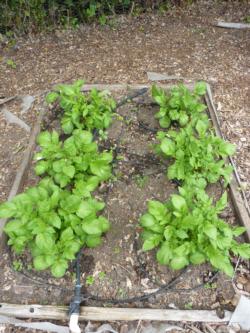
Bed B:
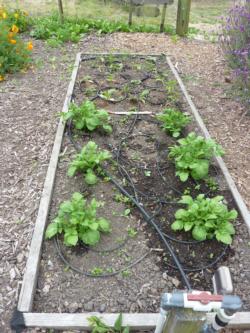
The plants were hilled again on May 24th and June 14th. Both beds received 10 minutes of drip irrigation every other day.
Results:
The foliage on both the inoculated and non-inoculated plants was healthy looking and robust considering it was a very cold, wet and foggy spring.
June 14th:
Bed A:height 32", width 36"
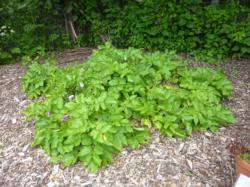
Bed B:height 28", width 25"
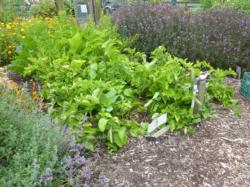
Harvesting in both beds began on July 19th and was completed on August 2nd.
Gopher tunnels were observed in both beds. At harvest, some potatoes were found to be half eaten and I would speculate that others were completely devoured. It is difficult to estimate the amount of loss.
Bed A with inoculum produced a total of 23.25 pounds of potatoes, large to medium in size. They were round, smooth and rather attractive.
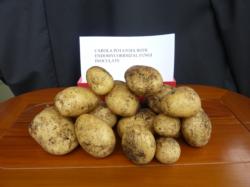
Bed B without inoculate produced a total of 26 pounds of potatoes, medium to small in size. About 50% were knobby and deformed looking.
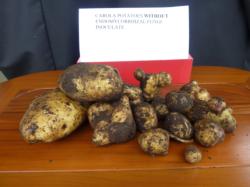
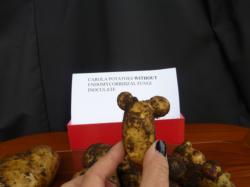
Conclusion:
Even though the yield was slightly greater in the non-inoculated bed, the spuds were not choice in appearance. I will personally continue to work with mycorrhizal fungi plant inoculum in the future, focusing on its application in new beds and soils that may be nutrient poor. I would caution the home gardener that if they are interested in pursuing this avenue of investigation, to purchase inoculum from a reputable source and do your homework first. Scientific analysis has shown that many of the ‘over the counter’ products that claim to contain live mycelium, do not in fact live up to that promise.
For more information, please contact the Master Gardener Help Line at (650) 726-9059 ext 107
Written by: Janet Didur, Master Gardener
